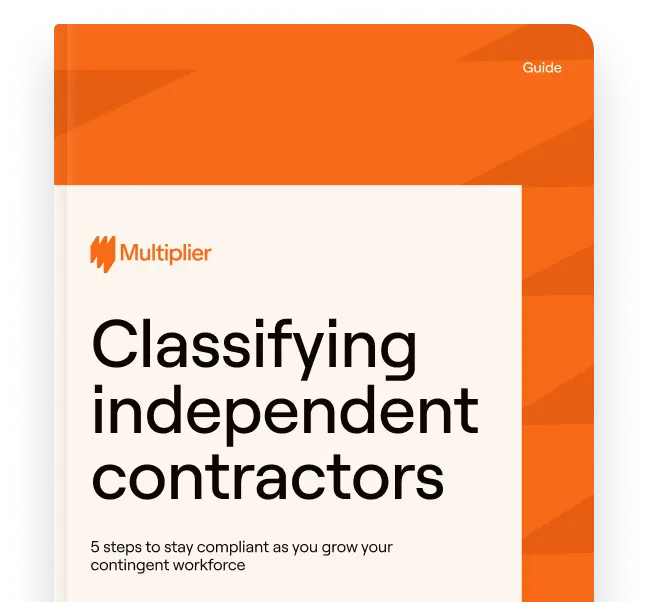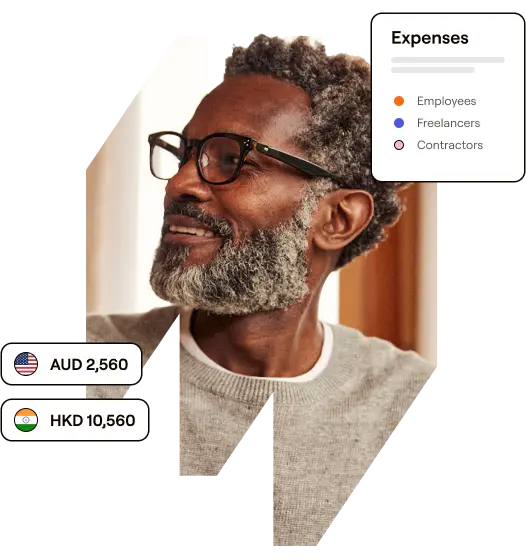Employee misclassification — treating someone like an employee while labeling them a contractor — can cost businesses millions.
Hiring independent contractors unlocks speed and agility, especially in the global hiring race. But there’s a catch: if you get the classification wrong, you’re looking at lawsuits, regulatory audits, and six-figure penalties.
With remote work on the rise and cross-border teams becoming the norm, the risk of misclassifying workers, whether due to oversight or ambiguity, has never been higher.
According to the US Department of Labor (DOL), misclassification has resulted in billions of dollars in unpaid taxes and denied benefits. For example, Uber alone agreed to pay New Jersey $100 million in back taxes and penalties from misclassification investigations in 2022.
That’s where compliance tools like Multiplier’s Contractor of Record, also known as Agent of Record (AOR), come in — helping businesses accurately classify and manage contractors across borders while reducing legal risk.
In this guide, we’ll explore the legal implications of misclassification, real lawsuits that made headlines, and how your company can avoid becoming the next cautionary tale.
To start, let’s define exactly what employee misclassification means in the modern workforce.
What is employee misclassification?
Employee misclassification happens when a company labels a worker as an “independent contractor” while treating them like a regular employee.
In practice, this might look like:
- Setting fixed work hours
- Requiring exclusivity
- Providing company-owned equipment
- Assigning tasks under tight supervision
These behaviors contradict the autonomy that independent contractors must retain under the law.
Intentional vs. unintentional misclassification
Some companies knowingly misclassify workers to cut costs on taxes, insurance, and benefits. Others may do so unintentionally due to complex or unclear classification rules. Regardless of intent, both forms can lead to legal penalties, fines, and back payments.
Regardless of why it happens, misclassification carries serious consequences for companies of any size.
Why employee misclassification matters
Beyond compliance, misclassification affects your employer brand, finances, and global expansion strategy. Governments are aggressively pursuing cases to protect worker rights and recover lost tax revenue.
Understanding these risks begins with a clear grasp of the legal frameworks that dictate worker classification in various jurisdictions.
The legal landscape: Laws governing classification
Before you classify a worker as a contractor, you must understand how the law views that relationship.
Federal regulations
- Fair Labor Standards Act (FLSA): Establishes minimum wage and overtime rights.
- Internal Revenue Service (IRS): Uses a 3-factor control test: behavioral, financial, and relationship control.
- National Labor Relations Act (NLRA): Protects collective bargaining rights — contractors aren’t covered.
State-specific laws
Some states apply even stricter tests. For example:
- California’s ABC test: Workers are presumed employees unless the company proves:
- The worker is free from control
- The work is outside the usual course of business
- The worker is independently established
Regional classification standards and key legislation (Global comparison)
Employee classification is regulated differently across regions, creating complex compliance challenges for global companies.
Country name | Primary test | Key factors | Regulatory body |
United States | Control and independence test | Economic dependence, behavioral control, financial relationship | IRS, Department of Labor |
United Kingdom | Employment status determination | Mutuality of obligation, personal service, control | HMRC |
European Union | Economic dependence test | Integration into organization, economic dependence | National labor authorities |
Latin America | Labor code compliance | Heavy employee protection, social security obligations | Ministry of Labor (varies by country) |
Australia | Multi-factor test | Control, independence, commercial basis | Australian Taxation Office |
Canada | Economic reality test | Level of control, ownership of tools, chance of profit/loss | Canada Revenue Agency |
These frameworks vary, but the takeaway is consistent, i.e., if you treat someone like an employee, the law likely will too.
Severe consequences: Lawsuits, penalties, and risks
Misclassification isn’t just a technical error; it can unravel your business operations.
Financial penalties and back wages
Misclassifying workers can lead to severe financial consequences across multiple categories, from tax violations to unpaid benefits. Here’s a breakdown of potential liabilities:
1. Tax violation fines
- Up to 3% of total wages paid to misclassified workers
- 100% of unpaid FICA taxes
- Up to 40% of employer-side taxes not withheld
- $50 per unfiled W-2 form
2. Federal law violation fines
- Civil penalties up to $1,000 per misclassified employee
- Retroactive payment of employee benefits
3. Back pay and overtime
- Repayment of unpaid overtime, severance, bonuses, and even healthcare contributions
4. US penalty structure breakdown
Misclassification often results in underpaid taxes and social contributions. Governments may require employers to pay retroactively.
- Income tax withholdings and social security contributions
- Employer-side payroll taxes and insurance premiums
- Unpaid benefits including paid leave, bonuses, and pension contributions
- Interest and penalties on overdue amounts
To avoid costly mistakes, consider using Multiplier’s misclassification assessment tool.
Here’s a closer look at common violations and the penalties they may trigger:
Violation type | Penalty amount | Additional consequences |
Unfiled W-2 forms | $50 per unfiled form | IRS investigation |
Unpaid federal income tax | 1.5% of wages | Criminal liability for willful violations |
FICA tax shortfall | 100% of employer’s share | Interest accrual from due date |
State tax violations | Varies by state | Additional state penalties |
Legal actions and litigation
Misclassified workers and government agencies can take legal action, leading to costly lawsuits and reputational damage.
Common types of legal actions include:
1. Individual lawsuits
Workers may sue for unpaid wages, denied benefits, and damages.
2. Class-action lawsuits
One misclassification can lead to dozens of retroactive claims.
3. Government eEnforcement
Agencies like the IRS and DOL conduct audits often triggered by whistleblowers or tax discrepancies.
In 2021, DoorDash settled a misclassification lawsuit worth over $ 100 million, with more than $16 million going directly to misclassified contractors. The court determined drivers were managed like employees but denied the associated benefits.
Criminal penalties
Intentional misclassification can carry criminal consequences, including imprisonment for up to one year in some jurisdictions.
Reputational damage
Besides fines, lawsuits damage your brand, hinder hiring, and may affect investor confidence.
Regulatory scrutiny and audit defense (What regulators examine)
When facing investigation or litigation, authorities scrutinize these critical factors:
Classification assessment matrix
Use the matrix below to identify key factors that distinguish contractors from employees — and understand the compliance risk each carries:
Factor | Contractor indicators | Employee indicators | Compliance impact |
Work scheduling | Flexible, self-determined | Fixed hours set by company | High |
Exclusivity requirements | Can work for multiple clients | Company-mandated exclusivity | High |
Payment method | Invoice-based project payments | Regular payroll processing | Medium |
Tools and equipment | Contractor-provided resources | Company-supplied materials | Medium |
Written documentation | Business service agreements | Employment contracts | Low (reality matters more) |
Defense strategy considerations
If answers indicate employee-style control, companies may still face liability, regardless of contractual language. Successful defense requires:
- Comprehensive documentation of business relationship
- Evidence of contractor’s independent business operations
- Proof of arm’s length commercial arrangements
- Demonstration of industry-standard practices
Why companies get misclassification wrong: Common triggers
Even well-intentioned companies misclassify contractors due to the common misclassification triggers mentioned in detail below.
Risk factor | Why it happens | Compliance impact |
Rapid scaling | Legal oversight can’t keep pace with hiring | High-volume violations |
Remote work assumptions | “Remote equals independent” misconception | Behavioral control issues |
Contract over reality | Focus on paperwork vs. actual relationship | Regulatory scrutiny |
Multi-jurisdiction expansion | Lack of local law expertise | Compound compliance failures |
Cost reduction pressure | Avoiding employee benefits and taxes | Increased audit risk |
How to avoid misclassification: Best practices for compliance
Preventing misclassification begins with understanding legal tests, maintaining proper documentation, and adhering to clear operational boundaries. Here’s how to stay compliant:
Understanding the tests
Use the IRS’s 3-prong test (behavioral, financial, and relationship control) or the ABC test where applicable.
Clear documentation and agreements
Contracts should define:
- Scope of work
- Autonomy
- Tax responsibilities
- No eligibility for benefits
Operational best practices
Don’ts:
- Set working hours
- Provide equipment
- Restrict other contracts
Dos:
- Pay per project/milestone
- Use contractor’s own tools
- Let them work independently
Seeking expert legal counsel and compliance solutions
Engage labor law attorneys and tools like Multiplier’s COR solution to avoid slip-ups.
Even with best practices, managing contractors globally can be complex — this is where a COR solution helps.
When to use a Contractor of Record solution
A COR can help you stay compliant when managing independent contractors globally. Use cases typically involve high compliance risk or operational complexity:
Ideal COR use cases
Consider a Contractor of Record when:
Scenario | Risk level | COR benefit |
Hiring in unfamiliar jurisdictions | High | Local expertise and compliance |
Rapid remote team scaling | Medium-High | Streamlined onboarding processes |
Multi-currency payment complexity | Medium | Automated compliance and payments |
Previous misclassification issues | High | Professional risk mitigation |
Limited internal compliance resources | Medium | Outsourced expertise and support |
Avoid fines and lawsuits with our misclassification quiz

Global spotlight: Major misclassification cases worldwide
The following high-profile cases highlight how regulators are tackling misclassification across regions:
Notable international cases and outcomes
Country | Company / Platform | Case details | Financial impact | Regulatory outcome |
United States | Uber | Driver classification under AB5 | $20M settlement | Forced reclassification |
France | Deliveroo | “Undeclared labor” violations | €375,000 fine | Criminal convictions |
United Kingdom | Uber | Employment tribunal ruling | Ongoing liabilities | Driver reclassification |
India | Swiggy, Zomato | PIL over gig worker rights | Pending | Regulatory review |
Brazil | iFood | Labor ministry investigation | $2M+ penalties | Compliance requirements |
Netherlands | Foodora | Court-ordered reclassification | €8M back payments | Platform restructuring |
Regional enforcement trends
- North America: Increasing state-level legislation targeting gig economy platforms with stricter classification tests.
- Europe: Growing focus on platform worker rights with proposed EU-wide legislation creating presumption of employment.
- Asia-Pacific: Emerging regulatory frameworks balancing innovation with worker protection, particularly in ride-sharing and delivery sectors.
- Latin America: Strong labor protections leading to aggressive enforcement against misclassification across multiple industries.
How Multiplier can help you support contractors and stay compliant
Employee misclassification is one of the most costly legal mistakes companies make when hiring contractors, particularly during global expansion. The financial and reputational consequences can be devastating, but they’re entirely preventable with proper planning and compliance systems.
Why choose Multiplier’s contractor of record solution
Whether you’re hiring in Brazil, India, the United States, or anywhere else globally, Multiplier’s Contractor of Record platform ensures every worker is classified correctly, paid compliantly, and managed securely.
Comprehensive compliance benefits:
- Verified classification across 150+ countries and territories
- Audit-ready documentation and record-keeping systems
- Fully compliant contractor payments and invoicing processes
- Reduced legal exposure, administrative costs, and HR burden
- Expert guidance on evolving global labor regulations
Multiplier covers every compliance angle from contractor onboarding through project completion and offboarding, giving you confidence in your global workforce strategy.
Ready to eliminate misclassification risk?
Book a demo today and safeguard your team from costly lawsuits and regulatory penalties.
FAQs
What are the main differences between an employee and an independent contractor?
Employees are supervised, receive benefits, and are subject to payroll taxes. Contractors are autonomous and self-managed.
What are the signs that an independent contractor might be misclassified?
Exclusivity, fixed hours, being managed like staff, or using company tools.
What should I do if I suspect I have misclassified employees?
Seek legal counsel immediately. Voluntary correction programs may reduce penalties.
How does intentional misclassification differ from unintentional in terms of penalties?
Intentional misclassification brings harsher penalties, while unintentional cases may face reduced fines — but both still carry legal and financial consequences.
Can misclassified employees sue my company?
Yes, both individually and through class-action lawsuits.
Learn the five steps to avoid misclassification

